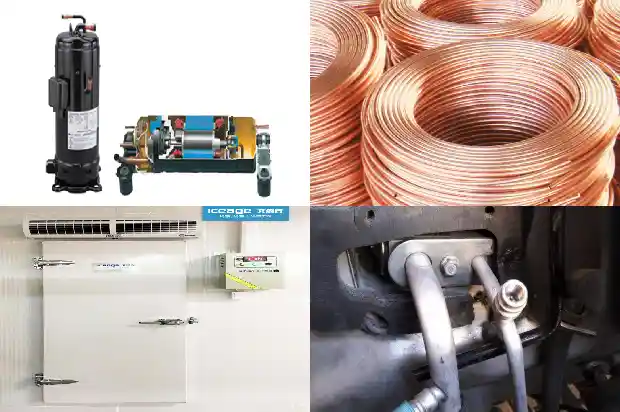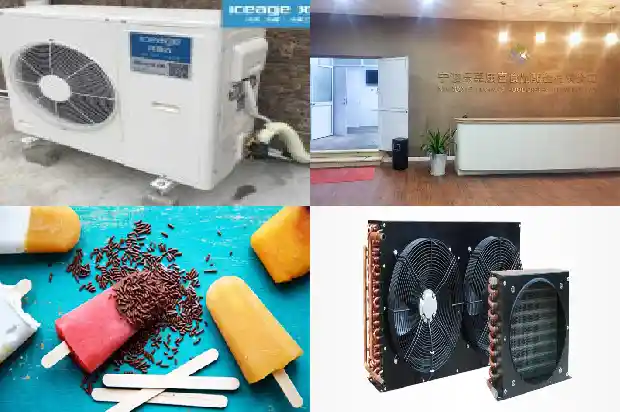Is the heating effect of air source heat pump air conditioner with enhanced vapor injection really good under low temperature conditions?
2024-09-28
Strictly speaking, the so-called "vapor injection enhanced enthalpy" technology is built on a complete system, which is composed of special components such as vapor injection enhanced enthalpy compressor, hot water heat exchanger, evaporator and so on. But the compressor plays a central role in it. So what is a vapor injection enhanced enthalpy compressor?
This kind of compressor adds an additional steam injection port. The compressor receives the energy transferred from the evaporator from the suction port and receives the steam supplemented from the other end of the pipeline from the steam injection port. The steam is used to cool the refrigerant (refrigerant) circulating continuously in the pipeline. The essential meaning of doing this is to use the entry of steam to divide the original one-stage compression process into a quasi-two-stage compression process.
To explain more clearly, we can analyze this process step by step:
Step 1: The compressor accepts the heat A absorbed from the air by the evaporator and starts to compress the energy A.
Step 2: Open the vapor injection enhanced enthalpy air supplement circuit and let steam enter the compressor.
Step 3: The part of energy A that is being compressed by the compressor is mixed with the incoming steam. This process will continue until the working chamber of the compressor is separated from the air supplement port. At this time, the steam and energy A are fully mixed to become a new energy B.
Step 4: After the working chamber of the compressor is separated from the air supplement port, energy B is subjected to "secondary" compression. Finally, energy B enters the condenser and exchanges heat with water.
So where does the "gas" in the air supplement come from?
This gas is generated by the flash evaporator in the air source heat pump. The flash evaporator has a connected pipeline with the compressor. Steam passes from the flash evaporator to the compressor along the pipeline. Whether to supplement air and when to supplement air are controlled by the opening and closing of the solenoid valve. Since the flash evaporator is actually located in the middle of the loop from the condenser to the evaporator.
When the flash evaporator supplements air to the compressor, it actually also increases the subcooling degree of the liquid refrigerant before throttling, so that the liquid refrigerant can better absorb the energy in the air in the evaporator. It is equivalent to indirectly increasing the energy A provided by the evaporator to the compressor. In addition, due to the air supplement received by the compressor, the displacement to the condenser also increases, so that the amount of refrigerant that exchanges heat with water in the condenser increases. It is these two factors that make the "vapor injection enhanced enthalpy" scheme improve the heating capacity of the unit in low temperature environments.
Regarding vapor injection enhanced enthalpy, some researchers have done experiments. The experimental comparison found that:
When cooling under standard conditions, the energy efficiency is equivalent. The heating capacity and energy efficiency ratio of ordinary air conditioners and a certain vapor injection enhanced enthalpy air conditioner are also equivalent;
In the heating state, the energy efficiency standard condition and heating capacity of the vapor injection enhanced enthalpy air conditioner are increased by more than 10%, and the energy efficiency ratio is much higher than that of ordinary air conditioners of 3.
For full-condition heating, the outdoor working condition is from ~15 degrees Celsius to 15 degrees Celsius, and the indoor working condition is adjusted to 20 degrees Celsius. Under various working conditions, a certain vapor injection enhanced enthalpy air conditioner increases the heating capacity by 25% compared with the conventional unit, and the lower the outdoor temperature, the more significant its heating capacity.
Under the same air volume, the outlet air temperature of a certain vapor injection enhanced enthalpy air conditioner is higher than normal temperature. At low temperature, it can be 5-7 degrees higher, which feels very comfortable and is hot air.
In the same room, when reaching the same temperature, a certain vapor injection enhanced enthalpy air conditioner is 1/10 faster than the conventional one.
Perhaps this set of experimental data has different performances according to different air conditioners, but it is undeniable that the enhanced enthalpy technology does not affect the cooling capacity and energy efficiency, and the enhanced enthalpy can also effectively improve the heating capacity and energy efficiency, especially saving electricity at low temperatures.
In reality, it has also been proved that the vapor injection enhanced enthalpy product can realize heating operation within ~25℃ to 29℃. Through vapor injection enhanced enthalpy, the heating capacity of the compressor in severe cold is increased. The heating capacity is increased by nearly 20%-50% at ~15℃, which makes the "strong cooling and heating" of the multi-connected unit more advantageous.
This kind of compressor adds an additional steam injection port. The compressor receives the energy transferred from the evaporator from the suction port and receives the steam supplemented from the other end of the pipeline from the steam injection port. The steam is used to cool the refrigerant (refrigerant) circulating continuously in the pipeline. The essential meaning of doing this is to use the entry of steam to divide the original one-stage compression process into a quasi-two-stage compression process.
To explain more clearly, we can analyze this process step by step:
Step 1: The compressor accepts the heat A absorbed from the air by the evaporator and starts to compress the energy A.
Step 2: Open the vapor injection enhanced enthalpy air supplement circuit and let steam enter the compressor.
Step 3: The part of energy A that is being compressed by the compressor is mixed with the incoming steam. This process will continue until the working chamber of the compressor is separated from the air supplement port. At this time, the steam and energy A are fully mixed to become a new energy B.
Step 4: After the working chamber of the compressor is separated from the air supplement port, energy B is subjected to "secondary" compression. Finally, energy B enters the condenser and exchanges heat with water.
So where does the "gas" in the air supplement come from?
This gas is generated by the flash evaporator in the air source heat pump. The flash evaporator has a connected pipeline with the compressor. Steam passes from the flash evaporator to the compressor along the pipeline. Whether to supplement air and when to supplement air are controlled by the opening and closing of the solenoid valve. Since the flash evaporator is actually located in the middle of the loop from the condenser to the evaporator.
When the flash evaporator supplements air to the compressor, it actually also increases the subcooling degree of the liquid refrigerant before throttling, so that the liquid refrigerant can better absorb the energy in the air in the evaporator. It is equivalent to indirectly increasing the energy A provided by the evaporator to the compressor. In addition, due to the air supplement received by the compressor, the displacement to the condenser also increases, so that the amount of refrigerant that exchanges heat with water in the condenser increases. It is these two factors that make the "vapor injection enhanced enthalpy" scheme improve the heating capacity of the unit in low temperature environments.
Regarding vapor injection enhanced enthalpy, some researchers have done experiments. The experimental comparison found that:
When cooling under standard conditions, the energy efficiency is equivalent. The heating capacity and energy efficiency ratio of ordinary air conditioners and a certain vapor injection enhanced enthalpy air conditioner are also equivalent;
In the heating state, the energy efficiency standard condition and heating capacity of the vapor injection enhanced enthalpy air conditioner are increased by more than 10%, and the energy efficiency ratio is much higher than that of ordinary air conditioners of 3.

For full-condition heating, the outdoor working condition is from ~15 degrees Celsius to 15 degrees Celsius, and the indoor working condition is adjusted to 20 degrees Celsius. Under various working conditions, a certain vapor injection enhanced enthalpy air conditioner increases the heating capacity by 25% compared with the conventional unit, and the lower the outdoor temperature, the more significant its heating capacity.
Under the same air volume, the outlet air temperature of a certain vapor injection enhanced enthalpy air conditioner is higher than normal temperature. At low temperature, it can be 5-7 degrees higher, which feels very comfortable and is hot air.
In the same room, when reaching the same temperature, a certain vapor injection enhanced enthalpy air conditioner is 1/10 faster than the conventional one.

Perhaps this set of experimental data has different performances according to different air conditioners, but it is undeniable that the enhanced enthalpy technology does not affect the cooling capacity and energy efficiency, and the enhanced enthalpy can also effectively improve the heating capacity and energy efficiency, especially saving electricity at low temperatures.
In reality, it has also been proved that the vapor injection enhanced enthalpy product can realize heating operation within ~25℃ to 29℃. Through vapor injection enhanced enthalpy, the heating capacity of the compressor in severe cold is increased. The heating capacity is increased by nearly 20%-50% at ~15℃, which makes the "strong cooling and heating" of the multi-connected unit more advantageous.
Related Articles
- Essential for Maintenance! Parameters and Phenomena of Normal Operation of Refrigeration and Heating Systems
- 9 Heating and Cooling Solutions: Pros and Cons You Must Know!
- What are the Cooling and Heating Pressures of an Air Conditioner? How to Calculate the Optimal Refrigerant Quantity?
- What Key Steps Should Not Be Ignored in Installing an Air - source Heat Pump Heating System?
- Air-source heat pump: Principle of cooling and heating in one machine
- What to Do if the Compressor of a Frozen and Refrigerated Display Cabinet Runs but the Refrigeration Effect Is Poor?
- Effective Measures to Prevent Compressor Failures in Industrial Chillers
- What are the effects of pressure and temperature on the refrigeration system of a cold storage?
- What Causes Poor Refrigeration Effect of Refrigerated Trucks?
- Influence of Fin Spacing of Evaporator in Air Cooler on Frost Formation
- Air - side Economizer
- Winter Approaches: How to Solve the Low High - pressure Issue of Air - cooled Condensing Units?
- What Are the Common Causes of Cold Air Blower Noise?
- How to Troubleshoot and Repair High - pressure Protection of Air - cooled Units?
- What Exactly Are the Ten Typical Malfunctions of Air Conditioners?
- What Misconceptions Should Be Avoided in Low - temperature Refrigeration System Repairs
- Practical Knowledge on Freeze Protection of Air - conditioning Equipment
- Remember! 3 Steps to Calculate Central Air - conditioner Cooling Capacity
